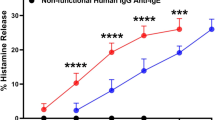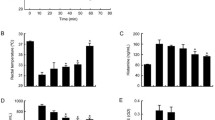Abstract
We have investigated the effects of the nitric oxide donor sodium nitroprusside on the immunologic release of histamine and tryptase from human mast cells. Isolated human skin mast cells were purified using Percoll gradient centrifugation. Mast cells with a purity of 70–90% were preincubated for 30 minutes with sodium nitroprusside and subsequently stimulated with anti-IgE. Upon challenge with anti-IgE, a release of 6.37±0.46 nmol histamine and 612±49 ng tryptase per 106 cells was observed. In presence of sodium nitroprusside a dose-dependent decrease of the release occurred. The results suggest that nitric oxide is effective in reducing the release of histamine and tryptase from human skin mast cells.
Similar content being viewed by others
References
J. R. Vane, E. E. Anggard and R. M. Botting,Regulatory functions of the vascular endothelium. N. Engl. J. Med.323, 26–36 (1990).
D. Salvemini, E. Masini, E. E. Anggard, P. F. Mannaioni and J. R. Vane,Synthesis of a nitric oxide-like factor from Larginine by rat serosal mast cells: stimulation of guanylate cyclase and inhibition of platelet aggregation. Biochem. Biophys. Res. Commun.161, 596–601 (1990).
F. J. van Overveld, P. G. Jorens, M. Rampart, W. A. De Backer and P. A. Vermeire,Tumour necrosis factor stimulates human skin mast cells to release histamine and tryptase. Clin. Exp. Allergy21, 711–714 (1991).
M. Feelisch and E. A. Noack,Correlation between nitric oxide formation during degradation of organic nitrates and activation of guanylate cyclase. Eur. J. Pharmacol.139, 19–30 (1987).
J. W. Park and G. E. Means,Formation of N-nitrosamines from sodium nitroprusside and secondary amines. N. Engl. J. Med.313, 1547–1548 (1985).
E. Masini, S. Bianchi, L. Mugnai, F. Gambassi, M. Lupini, A. Pistelli and P. F. Mannaioni,The effect of nitric oxide generators on ischemia reperfusion injury and histamine release in isolated perfused guinea-pig heart. Agents and Actions33, 53–56 (1991).
F. L. Pearce, H. Ali, K. E. Barrett, A. D. Befus, J. Bienenstock, J. Brostoff, M. Ennis, K. C. Flint, B. Hudspith, N. McI. Johnson, K. B. P. Leung and P. T. Peachell,Functional characteristics of mucosal and connective tissue mast cells of man, rat and other animals. Int. Arch. Allergy Appl. Immunol.77, 274–276 (1985).
F. J. van Overveld, L. A. M. J. Houben, F. E. M. Schmitz du Moulin, P. L. B. Bruijnzeel, J. A. M. Raaijmakers and G. K. Terpstra,Mast cell heterogeneity in human lung tissue. Clin. Sci.77, 297–304 (1989).
Author information
Authors and Affiliations
Rights and permissions
About this article
Cite this article
van Overveld, F.J., Bult, H., Vermeire, P.A. et al. Nitroprusside, a nitrogen oxide generating drug, inhibits release of histamine and tryptase from human skin mast cells. Agents and Actions 38, C237–C238 (1993). https://doi.org/10.1007/BF01996471
Issue Date:
DOI: https://doi.org/10.1007/BF01996471




